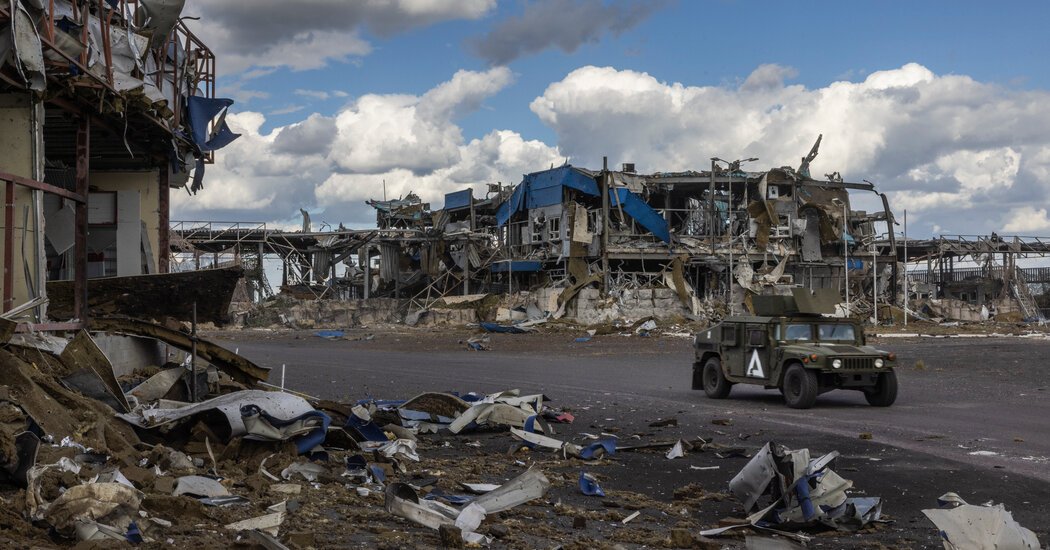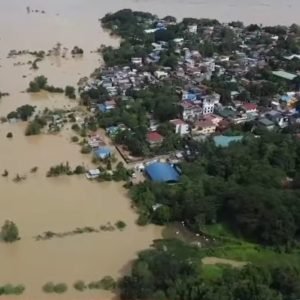
The scenes were decidedly Russian. A Gazprom facility. Flags with the country’s signature three horizontal stripes of white, blue and red. A Pyatyorochka supermarket.
The soldiers posting the videos, verified by The New York Times, were Ukrainian, almost giddily showing off just how easily they had pushed over the border and through Russian lines of defense in the past week.
In the Russian town of Sverdlikovo, a Ukrainian soldier climbed onto another’s shoulders, broke off the wooden post anchored to a town council building and threw the Russian flag to the ground. In Daryino, a town five miles to the west, other soldiers also grabbed a Russian flag. “Just throw it away,” a Ukrainian soldier said, grinning, as another flexed his muscles.
On Aug. 6, Ukraine launched an audacious military offensive, planned and executed in secrecy, with the aim of upending the dynamics of a war it has appeared to be losing, town by town, as Russian troops have ground forward in the east. The operation surprised even Kyiv’s closest allies, including the United States, and has pushed the limits of how Western military equipment would be permitted to be used inside Russian territory.
For Russia, it was a moment nearly as shocking as the mercenary Yevgeny V. Prigozhin’s march on Moscow in June 2023: the vaunted security state that President Vladimir V. Putin had built crumbled in the face of the surprise attack, failing in its basic task of protecting its citizens. And the unwritten social contract that has largely accompanied Mr. Putin’s 30-month campaign — that most Russians could get on with their normal lives even as he waged war — was cast into question anew.
Mostly on the defensive since a failed counteroffensive last year, Ukraine has pushed seven miles into Russia along a 25-mile front and taken dozens of Russian soldiers as prisoners, analysts and Russian officials say. The governor of Russia’s Kursk region said on Monday that Ukraine controls 28 towns and villages there. More than 132,000 people have been evacuated from nearby areas, Russian officials said.
“Russia brought war to others, and now it is coming home,” President Volodymyr Zelensky of Ukraine said in his Monday night address.
This offensive is a major gamble, especially since Russia dominates much of the frontline in Ukraine and has made significant inroads in the east. If Ukrainian troops are able to hold territory, they could stretch the capacity of Russian troops, deliver a major embarrassment for Mr. Putin and get a bargaining chip for any peace negotiations. But if Russia manages to push Ukrainian troops out of Kursk and simultaneously move forward in eastern Ukraine, Ukrainian military leaders could be blamed for giving the Russians an opening to gain more ground, particularly in the Donetsk region.
U.S. officials told The Times they were given no formal heads-up about the high-risk mission — possibly because Ukrainian officials feared the Americans would try to persuade Ukraine to call it off, possibly because of Ukraine’s obsessive concern over leaks. Ukraine was also using American-supplied vehicles, arms and munitions, despite President Biden’s caution in May that Ukraine could only use American-made weapons inside Russia for limited self-defense strikes.
U.S. officials have said that Ukraine’s cross-border offensive didn’t violate that policy. “They are taking actions to protect themselves from attacks,” Sabrina Singh, the Pentagon’s deputy press secretary, said on Thursday.
Ukrainian officials have remained tight-lipped about the mission, including whether they intend to hold ground or fall back to defenses on their side of the border. Mr. Zelensky only acknowledged the operation publicly for the first time on Saturday. Ukrainian soldiers said they didn’t know the plan in advance. Military analysts who spend their days tracking the war said they were surprised.
“This is a good example of how a modern successful operation requires extreme operational security measures and deception,” said Pasi Paroinen, an analyst from the Black Bird Group, a Finland-based organization that analyzes battlefield footage. He added that if analysts couldn’t detect it, the Russians might not be able to either.
A quiet buildup
There were hints of what was to come.
Maps of the battlefield compiled by independent analysts show that soldiers from brigades long fighting in the east had moved discreetly into Ukraine’s Sumy region, just across the border from Kursk. A drone battalion from the 22nd Mechanized Brigade, which for nearly a year had defended the beleaguered frontline town of Chasiv Yar, was spotted near the border in mid-July. Troops from the 82nd Air Assault Brigade, engaged in fierce combat near Vovchansk in Ukraine’s Kharkiv region, also shifted to the area. So did soldiers from the 80th Air Assault Brigade, which was at the forefront of fighting in the Kharkiv region this spring.
A few Russians noticed. A report was submitted to Russian military leadership about a month before the attack saying that “forces had been detected and that intelligence indicated preparations for an attack,” Andrei Gurulyov, a prominent member of Russia’s Parliament and a former high-ranking army officer, said after the incursion.
“But from the top came the order not to panic, and that those above know better,” Mr. Gurulyov lamented on national television.
Any movement could have been misconstrued as a new defensive posture. The Ukrainian Army sometimes splits brigades into smaller battalions scattered across the battlefield, and Sumy has long been rumored as a place where Russia might try opening a new front.
Few expected Ukraine to be able to launch a new offensive. Ukrainian brigades were running low on ammunition. Even as new weapons started arriving this spring and summer from the West, an almost fatalistic mood had taken hold of many Ukrainians, that they were losing ground in the east, foot by foot.
Ukraine shuffled parts of brigades into the Sumy area under the pretenses of training and picking up new equipment, said one brigade’s deputy commander, Lt. Col. Artem, who asked to be identified only by his first name and rank, in keeping with military protocol.
Heavy weaponry moved in. Soldiers piled into houses. The Ukrainians hid in plain sight. Officers were told to avoid wearing military uniforms when entering towns and cities so they didn’t draw attention, said one officer, who identified himself by his call sign, “Tykhyi,” in keeping with military protocol.
Some residents noticed the buildup. “Maybe they were reinforcing the border, or maybe building something?” said Elena Sima, the head of the Yunakivka district, about five miles from the border. “Everybody was guessing.”
In the village of Khotyn, the rumble of heavy, tracked vehicles woke up Natalya Vyalina, a 44-year-old kindergarten teacher, several nights in a row. She assumed others heard it, too. But in the village, she said, “nobody said anything.”
Even within the army, many were kept in the dark. Tykhyi — which means “quiet one” in Ukrainian — said some units were told of their mission only at the last moment.
On Aug. 3, Colonel Artem said, his brigade commander summoned senior officers to a meeting on the side of a forest road to announce the mission’s goals. To divert Russian troops to help fellow soldiers fighting in the eastern Donbas region. To push Russian artillery out of range of Sumy. To demoralize the Russians by showing their intelligence and planning failures.
‘Difficult challenges ahead’
The Ukrainian military hadn’t tried a serious push into Russia since the beginning of Moscow’s full-scale invasion in 2022. Commandos had made quick forays across the border, one in May 2023 and another this March. They were claimed by two shadowy paramilitary groups with ties to Ukraine: the Russian Volunteer Corps and the Freedom of Russia Legion.
Away from the fighting, the Kursk region posed an easier target than elsewhere along the 600-mile front in the east and south of Ukraine. It had fewer anti-armored vehicle ditches, fewer of the anti-tank pyramid obstacles known as dragon’s teeth and fewer manned fighting positions, said Brady Africk, an American analyst who maps Russia’s defenses. Russia also appeared to have sown fewer mines in the Kursk region than in occupied Ukrainian territories.
“Russia’s fortifications in Kursk are less dense than in other areas where Russian forces have built formidable defenses, such as in the south,” Mr. Africk said.
Just before noon on Aug. 6, Russian authorities claimed about 300 soldiers, more than 20 armored combat vehicles and 11 tanks from Ukraine’s 22nd Mechanized Brigade had crossed into the country. But those initial reports were greeted with a shrug. Disinformation and propaganda have become another kind of front in this war, and no one thought such an incursion made any tactical sense.
Hundreds more Ukrainian forces surged forward, breaching border checkpoints and pushing through two lines of defense. With fewer mines and fewer anti-military obstacles, Ukrainian mechanized brigades moved quickly.
Oleksandr, a Ukrainian infantry soldier who declined to give his last name, citing military security protocols, said many Russian soldiers fled as the Ukrainians pushed forward. Eight Russian soldiers surrendered at one checkpoint, he added.
Early Wednesday, senior U.S. officials woke up to a shock: They learned that more than 1,000 regular Ukrainian Army forces had crossed the border the day before, equipped with mobile air defenses and electronic-warfare equipment to jam Russian radar. Some were driving in armored vehicles sent by Germany and the United States. The soldiers appeared to be planning for an extended fight.
As late as Thursday, U.S. officials said, they were still seeking clarity from Ukrainian officials on the operation’s logic and rationale. Since then, Ukrainian leaders have briefed senior U.S. civilian officials and top military commanders on their goals.
The American officials said they were surprised at how well the operation has gone so far, but were skeptical that the Ukrainians could hold onto their gains. And in making the incursion, they said, Ukraine has created new vulnerabilities along the front where its forces are already stretched thin.
Videos show Ukrainian forces may have faced resistance at times, although there is not visual evidence of widespread losses.
Outside the Russian village of Kremyanoye, a video filmed by a Russian soldier shows Russian soldiers ransacking a captured Ukrainian armored vehicle, and taking away what appeared to be ammunition and other supplies. In another video filmed a few hundred meters away, a Russian soldier tried to rip a Ukrainian flag patch from the uniform of a dead soldier lying in the grass. Other footage, posted on Telegram by Russia’s Ministry of Defense, appeared to show Russian forces firing on a Ukrainian brigade around the Kursk region.
“We all have joy in our hearts,” the Ukrainian soldier, Oleksandr, said in a phone interview at 5 p.m. on Thursday, from somewhere inside Russia. “But we realize that there are still difficult challenges ahead.”
Some Ukrainian troops haven’t been able to stop themselves from publicizing their moves. They’ve posted videos and selfies from Russian towns like Sudzha or villages like Poroz and Dmitriukov, bragging about how they have finally taken the fight to Russia.
Outside a Pyatyorochka store in Sudzha, about six miles from the Russian border, one Ukrainian soldier said that a Ukrainian supermarket chain, ATB, was much better. “Glory to Ukraine,” he said in a video, which like others were verified by The Times. “No Pyatyorochka, ATB will be here soon.”
Four Ukrainian soldiers posed outside a nearby Gazprom facility, the Russian state-owned gas monopoly.
“From Sudzha, our news is as follows: The town is controlled by the armed forces of Ukraine,” one said, holding a rifle and standing in front of three soldiers brandishing a blue-and-yellow Ukrainian flag. “Peace in the town. All houses are intact.” He added: “I wish everyone a peaceful sky.”
One video filmed by Ukrainian forces showed Ukrainian armored vehicles gliding along roads and through open fields in the Kursk region. Another showed a convoy of a dozen or so burned Russian vehicle husks near the town of Rylsk, some 20 miles inside Russian territory. Bodies could be seen in the back of some trucks.
About three days after the incursion began, a Ukrainian strike destroyed an apparent munitions depot at Russia’s Lipetsk military airfield in the neighboring region.
Whether or not the strike was directly related to the ground advance, “Ukraine’s Kursk campaign de facto benefits,” said George Barros, an analyst with the Washington-based Institute for the Study of War.
A haphazard evacuation
For Russians near the border, the incursion arrived with loud booms. Roman, 49, a government worker who insisted on anonymity because he feared repercussions for speaking to a Western news outlet, said shelling woke him at 3:30 a.m. in his village outside Sudzha on Aug. 6, the first day of Ukraine’s incursion.
The next day, he and his wife drove to Kursk, the regional capital, because they knew their daughter’s school wouldn’t soon reopen. That night, they returned to evacuate their parents. They drove on side roads with their headlights off, stopping repeatedly to listen for drones.
Roman said people inundated him with requests for help reaching their relatives. He and others said the incursion appeared to have come as such a shock to the authorities that residents had to rely on each other.
A Sudzha resident named Ivan, 34, said in a text exchange Thursday that he was trying to evacuate residents. Later in the day, he wrote that he was in the hospital. His car had been hit by shelling while leaving Sudzha, home to around 6,000 people. And he had learned that the coffee shop where he worked had been damaged in the fighting.
“We’ve all been ditched,” Ivan said, also insisting on anonymity. “People are helping with whatever they can. The government doesn’t care.”
On Monday, the governor of Kursk said more than 100 civilians had been injured and a dozen killed, although the figures could not be independently verified.
The Times reviewed several satellite images captured since Aug. 6 that showed at least two dozen structures were damaged or destroyed in Sudzha and a neighboring village, Goncharovka, including homes, an apartment building, a gas station and support buildings of an arts school.
As the incursion expanded, the city of Kursk — whose name evokes for many Russians the enormous World War II tank battle nearby in which the Soviets stopped the German advance — filled with people fleeing the fighting. They lined up for help at aid centers set up by charity groups, Yan S. Furtsev, 38, an independent political activist in the city, said in an interview.
Nerves were frayed, he said, by shaky cellphone service and incessant air-raid warnings. Buses stopped when the sirens sounded. Those who couldn’t afford taxis were walking to work or relying on strangers for rides.
Whether the incursion would change people’s views on the war was another matter. On state television, the Kremlin played down the significance of the offensive, rather than casting it as a consequence of Russia’s invasion of Ukraine.
“There are a lot of different opinions” about the war, Mr. Furtsev said. “But as for what people think, everyone believes that this is a tragedy.”
Michael Schwirtz, Adam Entous, Dzvinka Pinchuk, Evelina Riabenko, Aric Toler, Christoph Koettl contributed reporting. Axel Boada contributed video production.







